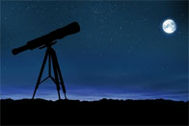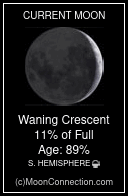| Satellite |
A natural or artificial body in orbit around a planet. |
| Saturn |
6th planet |
| Scarp |
A line of cliffs produced erosion or by the action of faults. |
| Schmidt Cassegrain |
A catadioptric telescope that combines a cassegrain reflector's optical path with a Schmidt corrector plate |
| Seyfert Galaxy |
A main-sequence star that rotates rapidly, causing a loss of matter to an ever-expanding shell. |
| Shell Star |
A type of star which is believed to be surrounded by a thin envelope of gas, which is often indicated by bright emission lines in its spectrum. |
| Shepherd Satellite |
A satellite that constrains the extent of a planetary ring through gravitational forces. Also known as a shepherd moon. |
| Sidereal |
Of, relating to, or concerned with the stars. Sidereal rotation is that measured with respect to the stars rather than with respect to the Sun or the primary of a satellite. |
| Sidereal Month |
The average period of revolution of the Moon around the Earth in reference to a fixed star, equal to 27 days, 7 hours, 43 minutes in units of mean solar time. |
| Sidereal Period |
The period of revolution of a planet around the Sun or a satellite around its primary. |
| Singularity |
The center of a black hole, where the curvature of space time is maximal. At the singularity, the gravitational tides diverge. Theoretically, no solid object can survive hitting the singularity. |
| Sirius |
A star - Brightest. Apparent magnitude -1.46. Dog star |
| Small Solar System Body |
A term defined in 2006 by the International Astronomical Union to describe objects in the Solar System that are neither planets or dwarf planets. These include most of the asteroids, comets, and other small bodies in the Solar System. |
| Solar Cycle |
The approximately 11-year quasi-periodic variation in frequency or number of solar active events. |
| Solar Eclipse |
A phenomenon that occurs when the Earth passes into the shadow of the Moon. A total solar eclipse occurs when the Moon is close enough to completely block the Sun's light. An annular solar eclipse occurs when the Moon is farther away and is not able to completely block the light. This results in a ring of light around the Moon. |
| Solar Flare |
A bright eruption of hot gas in the Sun's photosphere. Solar prominences are usually only detectable by specialized instruments but can be visible during a total solar eclipse. |
| Solar mass |
Mass of the sun 1.98892x10^30 kg |
| Solar Nebula |
The cloud of dust and gas out of which the Solar System was believed to have formed about 5 billion years ago. |
| Solar Wind |
A flow of charged particles that travels from the Sun out into the Solar System. |
| Solstice |
The time of the year when the Sun appears furthest north or south of the celestial equator. The solstices mark the beginning of the Summer and Winter seasons. |
| Southern Cross |
Constellation |
| Spectrometer |
The instrument connected to a telescope that separates the light signals into different frequencies, producing a spectrum. |
| Spectroscopy |
The technique of observing the spectra of visible light from an object to determine its composition, temperature, density, and speed. |
| Spectrum |
The range of colors that make up visible white light. A spectrum is produced when visible light passes through a prism. |
| Spicules |
Grass-like patterns of gas seen in the atmosphere of the Sun. |
| Spiral Galaxy |
A galaxy that contains a prominent central bulge and luminous arms of gas, dust, and young stars that wind out from the central nucleus in a spiral formation. Our galaxy, the Milky Way, is a spiral galaxy. |
| Star |
A giant ball of hot gas that creates and emits its own radiation through nuclear fusion. |
| Star Cluster |
A large grouping of stars, from a few dozen to a few hundred thousand, that are bound together by their mutual gravitational attraction. |
| Steady State Theory |
The theory that suggests the universe is expanding but exists in a constant, unchanging state in the large scale. The theory states that new matter is being continually being created to fill the gaps left by expansion. This theory has been abandoned by most astronomers in favor of the big bang theory. |
| Stellar Wind |
The ejection of gas from the surface of a star. Many different types of stars, including our Sun, have stellar winds. The stellar wind of our Sun is also known as the Solar wind. A star's stellar wind is strongest near the end of its life when it has consumed most of its fuel. |
| Stone Meteorite |
A meteorite that resembles a terrestrial rock and is composed of similar materials. |
| Stony Iron |
A meteorite that contains regions resembling both a stone meteorite and an iron meteorite. |
| Sun |
Star. 8.316 light minutes from Earth. |
| Sunspot |
Areas of the Sun's surface that are cooler than surrounding areas. The usually appear black on visible light photographs of the Sun. Sunspots are usually associated disturbances in the Sun's electromagnetic field. |
| Supergiant |
The stage in a star's evolution where the core contracts and the star swells to about five hundreds times its original size. The star's temperature drops, giving it a red color. |
| Superior Conjunction |
A conjunction that occurs when a superior planet passes behind the Sun and is on the opposite side of the Sun from the Earth. i.e. Earth-Sun-Object |
| Superior Planet |
A planet that exists outside the orbit of the Earth. All of the planets in our solar system are superior except for Mercury and Venus. These two planets are inferior planets. |
| Supernova |
A supernova is a cataclysmic explosion caused when a star exhausts its fuel and ends its life. Supernovae are the most powerful forces in the universe. All of the heavy elements were created in supernova explosions. |
| Supernova Remnant |
An expanding shell of gas ejected at high speeds by a supernova explosion. Supernova remnants are often visible as diffuse gaseous nebulae usually with a shell-like structure. Many resemble "bubbles" in space. |
| Synchronous Rotation |
A period of rotation of a satellite about its axis that is the same as the period of its orbit around its primary. This causes the satellite to always keep the same face to the primary. Our Moon is in synchronous rotation around the Earth. |
| Synodic Period |
The interval between points of opposition of a superior planet. |

